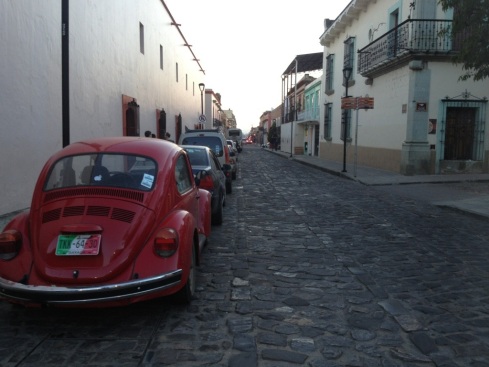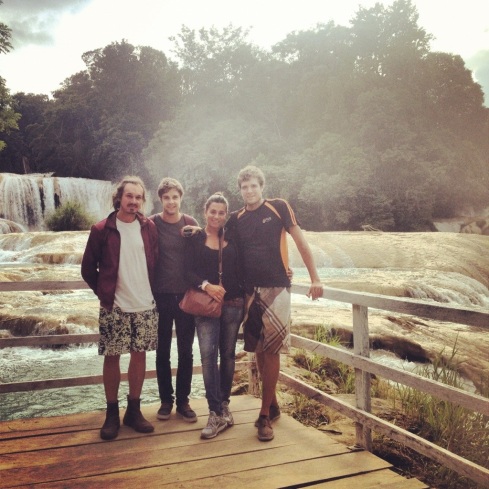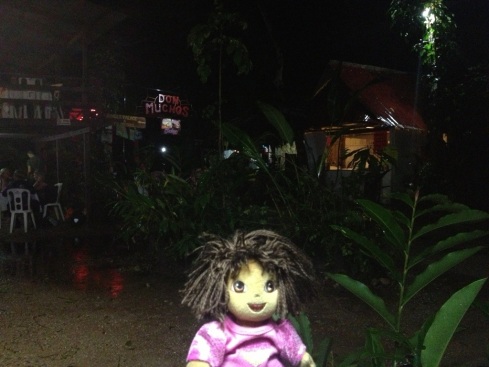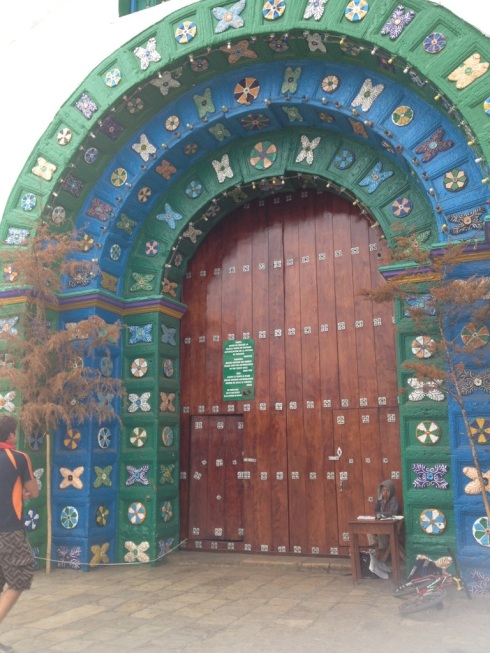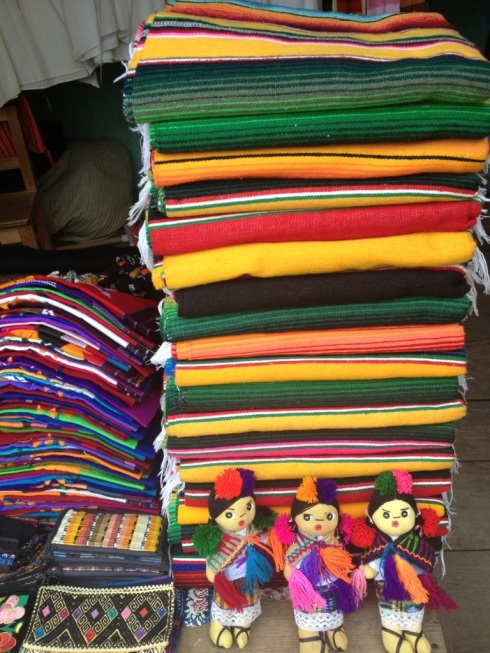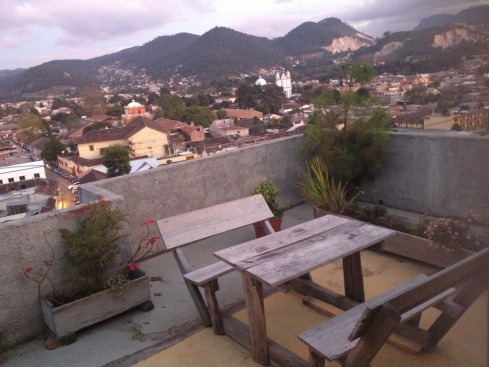On our first day in San Cristobal we had breakfast in a nice colonial place and reached the Zocalo, the main square of the town with gardens and a big Kiosk in the middle.
The historic center of San Cristobal has a Spanish colonial layout, with Baroque to Neoclassical style, beautiful buildings painted in various colours with Moorish hints.
The majestic yellow Baroque Cathedral with its red ledges and the big white building as the City Hall are the main attractions of this square.
I loved that fresh mountainous air of San Cristobal and the fact that wherever you are you will notice to be surrounded by hills.
Even if it is situated in a tropical zone, its climate is temperate and humid due to the altitude thus you need to carry some winter clothes, which I didn’t really have. I felt like when walking in February in Barcelona, when it is pretty cold there, I looked at the North European tourists walking with Havaianas and other flip-flops. nd I used to find it ridiculous.
Well, I am sure somebody has thought the same of me when walking the street with spring clothes with 7 degrees. What goes around comes around, no?
That morning we walked through the large open-air crafts market, with colourful and nice stalls mostly of textiles, amber and food and I saw many “sabrosas” – macadamia nuts vendors.
I had fun taking pictures of Dora with the ” Marcos”, little dolls representing the Zapatista activists with their typical black dresses and also a nice photo with a bunch of artisanal dolls that would be considered new little friends for her.
Paul and I noticed a tattoo shop, walked in and we both decide to have one. All happened so fast! I change my mind often but I surprise of myself that I never regret things. That’s why I love tattoos. I will always consider special regardless what could happen “tomorrow”.
I finally had a tattoo I was about to do in London few weeks before to leave, ” Fernweh “, a German noun that means, “crave for travelling, homesickness from a place you have never been”. I had always loved that word which apparently has never been properly translated with the same meaning.
Some would translate it as ” wanderlust” but that did not convince me. So I decided to keep it as the original noun.
Paul wanted to write on his arms “whatever makes you happy” but he finally had it in Spanish so to give more value to it being in Mexico. His tattoo was finally “lo que te hace feliz”. One has always to do whatever makes us happy. And I have probably chased this need all my life.
We were both happy and satisfied for our new inscriptions on the body and went back to the hostel for some rest.
At the Iguana hostel we met nice people, we first had some beers and then went for a walk and to a popular “Tacos” place. We talked about random things and even played cards, Asso. I don’t like cards but enjoyed it anyway.
We were a group of people from Italy, Australia, Germany, Holland, Canada, Usa and Israel.
That night I started to feel my cough was getting worse, and since I didn’t feel in shape I decided to stay at the hostel writing the blog and having a nice conversation with a nice Dutch guy who perfectly spoke Italian.
Of course he reminded me of my lovely other half and friend Sandrine and I imagined her to be fluent in Italian soon after the big efforts and Italian classes she is taking.
The day after we decided to move to another hostel; we had seen it just in photo when we had arrived at the bus terminal: Puerta Vieja hostel, and actually it turned to be an incredible place! We loved it immediately.
It had opened since few days, you could smell the brand new flavour everywhere, the dorms were amazing, rustic, country-style with colourful blankets.
We had a huge room for us and slept in mattresses that had never been used before. It was like being on a family trip, and I loved laying on the clean, fresh and comfortable bed and listening to Paul or Kevin playing the guitar just outside the room.
The kitchen was amazing and I was glad I could cook a little bit since I was missing it.
I cooked for two nights in row pasta for dinner for the five of us and a lovely German girl friend of the guys called Greta.
She had just been in Brazil for an interchange and was now travelling Central America. She had such a sweet smile, incredibly funny and looked really smart too.
In the morning I prepared often breakfast with my (modestly) delicious scrambled eggs.
I was happy to taking care of the guys in terms of food and I was also the official guide of the tour. But they were taking care of me so bad. I like the fact that I am independent from any human being, and I learnt to live on my own and do things despite the fact you have company or not. But I love good company, I love to forget how good I can stay alone when there’s good people to protect me and taking care of me. They were always taking care of me and never let me alone especially at night.
They started to call me Mamita thinking that it was a name for a mum but on their side they were
I felt so protected and safe at all times. It was nice to notice that if I ever stopped to see a shop or taking a picture, one of the guys was always waiting for me with a smiley face.
One day I woke up later than usual and I found the breakfast done by all of them for me with wonderful croque madames. I felt lucky! They said I deserved it J
That hostel helped our experience in Chiapas to be even more magical. It was supreme, with wide common space, a huge and functional kitchen and many bathrooms. There is about a bathroom every 2 people with great and warm showers, which is not to be given for granted in hostels.
Its majestic patio with long white arches and beautiful pictures on the wall, the big large wooden table where to have a nice breakfast while listening to music, is just few of the great aspect place where everybody can feel a home.
There is also a bar on the top of the house, it is still under construction but I can assure you that it was already beautiful like that, with stunning 360 degrees views on the town.
There is a soul at Puerta Vieja hostel; it is a beautiful project of few young entrepreneurs with the help of a great young architect called Daniela.
I wish them all, especially Dani Fernando and another lovely guy (who helped me not to freak out when none of my travel companion came back to the hostel a morning after partying) the best of luck for this project and that they will be able to fill all the 50 people capacity hostel.
Puerta vieja location is great, being situated on one of the main street called Diego de Mazariegos: full of shops, a big supermarket and a couple of minutes walk from the Zocalo.
In the back of the hostel there is a big garden where every night people would gather and sit all around a bonfire, with an external sauna made of stone and a beautiful antique door hanged on the walls increasing the magic atmosphere of the place.
At night we had a lot of fun at the hostel especially for Daniela – the architect – it was her birthday, and the guys organized a surprise party with usual bonfire, a piñata and a lot of food and drinks.
There were people from different part of the world; I enjoyed talking to a sweet and easy-going nice guy from Israel called Itamar. He had beautiful, kind of grey eyes.
There were also 2 nice hippy girls from New Zealand and a vegan Australian who were sat in circle meditating and after that all of them jumped on the fire in order to “leave the past behind”.
Meantime Justin and me prepared delicious jacket potatoes that took about 3 hours to cook. But it was worth to wait! Patience is golden !
One day, wandering through the town we found a lovely cultural center called ‘Tierradentro’ and it would become our favourite spot in San Cristobal: a large patio with autonomous “Zapatista” cooperatives in inside.
I loved the giant world map at the entrance, I probably never saw such a big one and we had fun taking pictures kissing Mexico and the Aussies indicating their so far away country.
We would go there on a daily basis, sometimes up to 3 times a day delighting its amazing coffees, salads, meat and a delicious authentic pizza with Nutella, which would be my little daily whim.
In San Cristobal there is a great food choice; many foreign residents have opened up restaurants with specially Italian and French meals.
There is an amazing French bakery on Calle Guadalupe called Oh-la-la where I strongly suggest you to go and feel like you are in a patisserie of Les Marais in Paris.
In terms of shops there is a good variety going from the basic cheap artisan things to the most sophisticated handcrafts of a beautiful shop called Eklektic.
I was very sick during the entire stay at San Cris, taking antibiotics and syrups instead of the rivers of alcohol the guys were consuming all day long. But it was special anyway.
More than once I was told by locals to drink tequila and all the pain would leave, or at least it would help to forget about it for some hours.
It is so bad but frequent while traveling getting sick, maybe for the change temperature, the sometimes cold showers in the hostels, travel stress (yes, it exist), tiredness and the long rides in buses with air conditioning and no open windows, with easy access to viruses.
In Chiapas lives a large indigenous population, made up of mostly Tzotzils and Tzeltals, the most important ethnic groups. It was bizarre to find out that the two languages are pretty different and they don’t understand each other.
We were so comfortable at the hostel that we all turned into lazy, even more for me, as I was feeling pretty sick.
There’s a nice garden inside the Casa de la Cultura de Chiapas. It is worth a walk inside with big handlooms on a side, and big colourful Mexican canvas on the other.
It is very close to San Cristobal Church, situated atop a long staircase up the hill: 300 steep stairs. About its half way there’s a sign ” no tirar basura,” do not trash bins and on its right a little hut made of recycled bottles and its tops and corks: very original.
Also, we bumped into many chickens on the stairs and a lovely about 2-year-old kid that, as soon as Paul said “hola” started to scream and cry, as you would see in a candid camera show.
The church was closed but the panoramic views of the city were amazing.
Plus, we had fun among the vintage yellow gym tools in the backyard.
As during the previous day we had been quite lazy we decided to make a double effort and walk all the way to the Guadalupe Church on the Guadalupe hills. Quite a long walk but less stairs though.
We walked by many shops during the long walk; especially a winery called Proyecto 25, then a marqesita shop where I had one filled with Nutella, a nice “casa de te” called Lum and different homemade chocolate shops.
While walking by the cathedral I met again Lena, a young German girl I had first met at Cielo rojo hostel in Oaxaca and after few days by chance at Posada del arquitecto in Mazunte. Many many km away.
Again incredible to meet randomly travellers met before.
At night we made a rendez vous with her at another favourite spot: la Vina de Bacco, a kind of tapas concept bar, where you receive some little dish whenever you buy a bottle of wine. Its owners are Italian.
We had a lot of fun, and met other people from the hostel; we enjoyed some minutes of live music from a smiley and funny Romanian traveller.
I got a bizarre proposal from an American murals artist who offered me consultancy for my blog in change of some afternoons to spend together. He said he was also an editor. He might have been useful for my blog but he was a little bit awkward, I didn’t give him my email on purpose but he gave me his. I never wrote him back. I thought: I would never meet him again. But puff…. I didn’t know that I would bump into him face to face a week later in the streets of Palenque, 6 hours bus away.
The world is little, I felt a little bit guilty but I acted as I had not seen him.
And Chiapas is a place I would strongly recommend you all to visit.




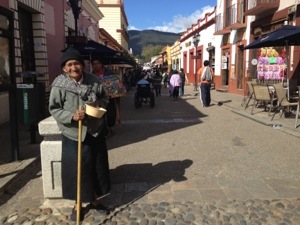
Tags: canon del sumidero, chiapas, guadalupe, hostal iguana, Lum, mexico, mexico city, nutella, proyecto 25, puerta vieja hostel, San Cristobal, san cristobal de las casas, tattoo














